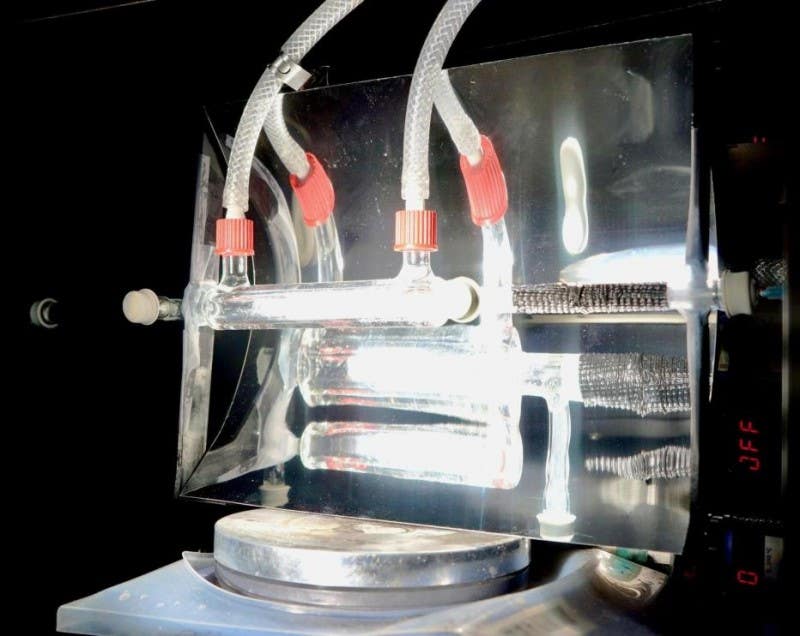Researchers discover how to stick sensors to skin without adhesive
Imagine if you could attach something to your skin without needing glue. A biosensor, a watch, a communications device, a fashion accessory

[August 10, 2021: Binghamton University]
Imagine if you could attach something to your skin without needing glue. A biosensor, a watch, a communications device, a fashion accessory — the possibilities are endless. Thanks to a discovery at Binghamton University, State University of New York, that time could be closer than you think.
Associate Professor Guy German and Zachary Lipsky, PhD ’21, recently published research in the journal Acta Biomaterialia that explores how human skin can control the way cracks form and why tensometers offer imprecise results when measuring the mechanical properties of biological tissues.
Along the way, Lipsky developed a method to bond human skin to rubber-like polymeric materials without an adhesive. Originally a way to make their experiments easier, he and German understood they had made a significant discovery.
“Zach came in one day and said, ‘Yeah, I did it,’” German said. “I was like, ‘How on Earth did you do that? Did you use a glue?’ Because we’d need to account for the mechanical properties of the glue as well. And he said, ‘No, I just stuck it.’ We looked and said: Has this ever been done before? Never been done. So we’re really happy on that front.”
An invention disclosure for the technique has been filed, which could lead to a patent on what he calls “a very simple technique” that could revolutionize biotech.
“I didn’t know we’d end up there, but that’s sometimes how science works,” German said with a laugh.
The study that spawned the discovery, titled “The Precision of Macroscale Mechanical Measurements is Limited by the Inherent Structural Heterogeneity of Human Stratum Corneum,” started with German’s roots in mechanical engineering and his interest in testing the validity of Hooke’s law to human skin.
“We thought, if we use these standard testing techniques to measure the mechanical properties of tissue, especially skin tissue, is it reporting the right values?” he said. “No one’s really ever validated it.”
Developed by 17th-century British physicist Robert Hooke, the law states that the force needed to extend or compress a spring by a distance is proportional to that distance. More generally, researchers can use this law to measure the stiffness of different materials as well as how much energy it costs to break them.
“It got me thinking that, in modern times, you can measure how stiff metals and ceramics are. But what about skin?” German said. “Metals or ceramics have a composition that is fairly uniform, but skin and other tissues have a complex and heterogeneous structure with microscale cells connected by cell-cell junctions. The outer layer of skin also exhibits a complex topographical network of microchannels, which are visible if you look at the back of your hand.”
He and Lipsky bonded skin samples to a piece of polydimethylsiloxane (PDMS), a rubber-like material commonly used in bioengineering and biomedical devices. The samples were then stretched. A modified traction force microscopy technique was then used to quantify changes in the mechanical loads imparted by the skin on the adherent substrate.
“As the skin expanded, a little crack would grow, and we can measure how much energy it required to grow it by a certain length,” German said. “Typically to measure the energy cost of rupture in mechanical engineering you get two grips, you pull and it splits. You measure the force and displacement and quantify the energy. But this assumes that the material is homogeneous — compositionally the same everywhere. What we found out was that cracks in the skin’s outer layer propagate in a very, very weird way.”
The cracks propagate along the topographical microchannels. This elongates the overall path of the crack, increasing the energy it costs to break the tissue. The discovery can be extrapolated to explain the behaviors of other human tissues.
“Because of the heterogeneous structure of skin, it also means that the crack path becomes a lot more random. That’s why you get such variability in macroscale tensometer measurements of skin,” German said, “because even though you get the skin from exactly the same source at exactly the same age, the sample-to-sample variability is so high because the crack paths deviate.”
For more technology news stories check out our New Innovations section at The Brighter Side of News.
Like these kind of feel good stories? Get the Brighter Side of News' newsletter.
Tags: #New_Innovations, #Skin, #Medical_News, #Surgery, #The_Brighter_Side_of_News



